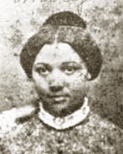Emily Edmonson
1835-1895

Emily Catherine Edmonson was born in Montgomery County circa 1835, the daughter of Paul and Amelia Edmonson, a free black man and an enslaved woman. Emily was one of fourteen children, all of whom were born into slavery due to common law in slave states, which held that legal status followed the mother's rank. Emily and her older sister Mary were sent to work as slaves in one of Washington's elite private homes, while their other siblings were forced to work as servants, laborers, or skilled workers.
On April 15, 1848, thirteen-year-old Emily, her fifteen-year-old sister Mary, and four of their brothers joined a group of slaves in an escape attempt on the ill-fated journey of the Pearl. The story of the Pearl has been documented by one of its captains, Daniel Drayton, in his memoirs and by Harriet Beecher Stowe in A Key to Uncle Tom's Cabin, a documentary account of slavery in the U.S. In what was considered the "largest concerted slave escape ever attempted on the Underground Railroad," 77 slaves hid among boxes transported down the Potomac towards the Chesapeake & Delaware Canal on the Chesapeake Bay. The Pearl was reported to authorities as suspicious by a passing steamer's captain. It was captured and taken back to Washington, D.C., and the slaves were incarcerated in a local jail.
Emily and Mary were taken to New Orleans, a market well known for trading young girls for use as prostitutes, also known as "fancy girls," but they were returned to Alexandria, Virginia when a yellow fever epidemic erupted. Paul Edmonson continued his tireless campaign to free his daughters. Armed with letters from supporters, he went to the New York offices of the Anti-Slavery Society, where he was sent to discuss his situation with the Rev. Henry Ward Beecher. Beecher's church members in Brooklyn raised the necessary funds to purchase the girls' freedom. Emily and her sister Mary were liberated on November 4, 1848.
After obtaining the sisters' freedom, the Brooklyn church continued to contribute money so they could attend school. Emily overcame the oppression of slavery, championing the emancipation of slaves, working as an outspoken abolitionist alongside Frederick Douglass and others. While studying, Emily and Mary traveled in the state of New York to participate in anti-slavery rallies. Both sisters attended the protest convention in Cazenovia during the summer of 1850 to demonstrate against the Fugitive Slave Act, later passed by Congress. The convention, led by Frederick Douglass, declared all slaves to be prisoners of war and warned the nation of an unavoidable insurrection of slaves unless they were emancipated.
In 1853, Emily and Mary Edmonson attended the Young Ladies Preparatory School at Oberlin College in Ohio through the support of Rev. Beecher and his sister, Harriet Beecher Stowe. After her sister's death from tuberculosis at the age of 20, eighteen-year-old Emily returned to the Washington D.C. area and enrolled in the Normal School for Colored Girls in Washington, D.C. under the tutelage of Myrtilla Miner. The school trained young African-American women to become teachers.
By 1860, Emily was married. After living for many years in Sandy Spring, Maryland, Emily and her husband moved to Anacostia, where they became founding members of the Hillsdale community. Emily continued working in the abolitionist movement and maintained her relationship with her neighbor, Frederick Douglass. One of Emily's granddaughters is quoted as having written, "Grandma & Frederick Douglass were like sister and brother—great abolitionists. I sat on his knee in his office in the house that is now a museum in Anacostia where we were born." Emily Catherine Edmonson Fisher Johnson died on September 15, 1895.
Emily Edmonson persevered in the face of oppression and enslavement. Even after she was finally liberated from slavery she continued to work tirelessly for the cause of emancipation, often in the face of imminent danger. Without the work of people like Emily Edmonson, life in Maryland and the United States would not be what it is today.
Ms. Edmondson's story was highlighted in an article by Mary Kay Ricks in the February 17, 2002 Washington Post Magazine article, "A Passage to Freedom," and is documented in A Key to Uncle Tom's Cabin, by Harriet Beecher Stowe, author of Uncle Tom's Cabin, in 1852.
